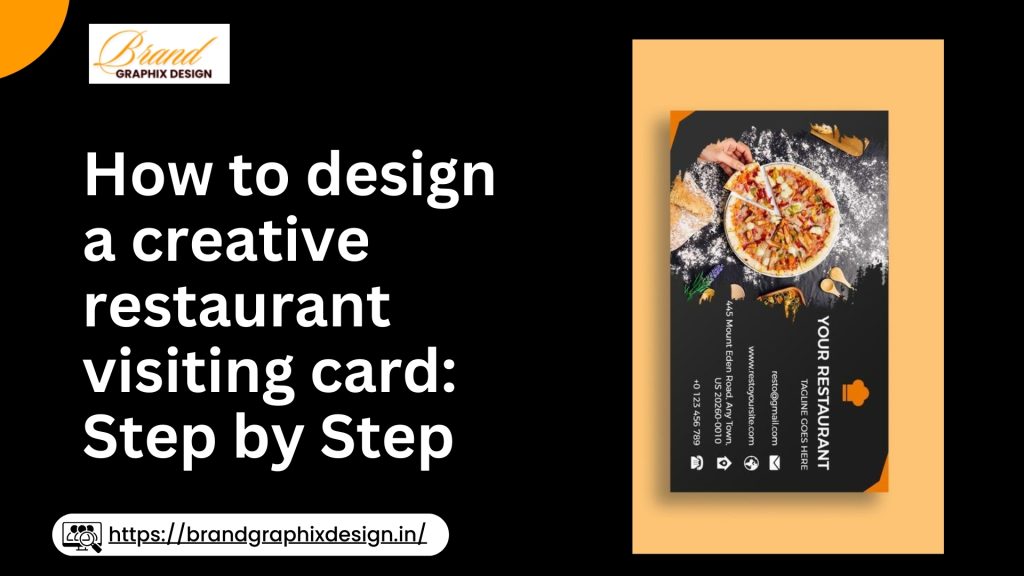Introduction
Designing a creative restaurant visiting card is an essential step in building your brand and making a lasting impression on your customers. A well-designed visiting card can convey the personality of your restaurant, provide important information, and encourage potential customers to visit. This step-by-step guide will help you create a unique and effective restaurant visiting card.
Why a Visiting Card Matters
Your restaurant’s visiting card is often the first point of contact with potential customers. It serves as a miniature representation of your brand and provides essential information. Here’s why a visiting card matters:
- First Impressions: A well-designed card creates a positive first impression and reflects the quality of your restaurant.
- Brand Identity: It reinforces your brand identity and helps customers remember your restaurant.
- Contact Information: It provides customers with your contact details, making it easy for them to reach you.
- Marketing Tool: It acts as a marketing tool, encouraging word-of-mouth referrals and repeat visits.
Step 1: Define Your Brand Identity
Before you start designing your restaurant’s visiting card, it’s important to define your brand identity. Your card should reflect the style, theme, and personality of your restaurant. Consider the following elements:
Logo
Your logo is the most recognizable element of your brand. Make sure it is prominently featured on your visiting card. If you don’t have a logo, consider hiring a designer to create one that represents your restaurant’s unique identity.
Color Scheme
Choose a color scheme that reflects the ambiance of your restaurant. For example, warm colors like red and orange can convey a cozy and inviting atmosphere, while cool colors like blue and green can suggest a calm and relaxing environment.
Font Style
Select a font style that matches your restaurant’s theme. A fancy script font might be suitable for a fine dining restaurant, while a bold, modern font could work well for a trendy café.
Tagline
If your restaurant has a tagline, include it on your visiting card. A catchy tagline can reinforce your brand message and make your card more memorable.
Step 2: Gather Essential Information
Your visiting card should provide all the necessary information that potential customers need to contact you or visit your restaurant. Here’s what to include:
- Restaurant Name: Clearly display the name of your restaurant.
- Contact Details: Include your phone number, email address, and website. Make it easy for customers to reach you.
- Address: Provide the complete address of your restaurant, including any landmarks if needed.
- Social Media Handles: Add your social media handles to encourage customers to follow you online.
- Operating Hours: Mention your restaurant’s operating hours so customers know when to visit.
Step 3: Choose the Right Card Size and Shape
The size and shape of your visiting card can make a big difference in its impact. While the standard size for business cards is 3.5 x 2 inches, you can experiment with different shapes and sizes to make your card stand out. Here are some options:
Standard Rectangular Cards
The most common choice, standard rectangular cards are easy to carry and fit into wallets and cardholders. They are a safe and practical option for most businesses.
Square Cards
Square cards offer a unique look and can make your card more memorable. They are slightly less common, which can help your card stand out from the rest.
Die-Cut Cards
Die-cut cards come in custom shapes that reflect your restaurant’s theme. For example, a card shaped like a chef’s hat or a pizza slice can add a fun and creative touch.
Folded Cards
Folded cards provide extra space for information and design elements. They can be particularly useful if you have a lot of details to include.
Step 4: Design the Front of the Card
The front of your visiting card should be visually appealing and convey the essence of your restaurant. Focus on the following elements:
Logo Placement
Place your logo prominently on the front of the card. It should be the focal point of the design, ensuring that it catches the viewer’s attention.
Background Design
Choose a background design that complements your logo and brand colors. You can use solid colors, gradients, or subtle patterns to create an attractive backdrop.
Tagline and Restaurant Name
Include your restaurant’s name and tagline, if you have one, on the front of the card. Make sure the text is legible and stands out against the background.
Step 5: Design the Back of the Card
The back of your visiting card is where you can include additional information and design elements. Here’s what to consider:
Contact Information
List your contact details, including phone number, email address, website, and social media handles. Ensure the text is clear and easy to read.
Address and Operating Hours
Provide your restaurant’s address and operating hours. This information should be easy to find and understand, helping customers plan their visit.
Additional Design Elements
You can add extra design elements like icons, illustrations, or photos to enhance the back of the card. Just make sure not to overcrowd the space, keeping the design clean and professional.
Step 6: Choose the Right Paper and Finish
The choice of paper and finish can greatly affect the look and feel of your visiting card. Here are some options to consider:
Paper Quality
Choose a high-quality paper stock that feels sturdy and durable. Thicker paper stocks give a more premium feel to your card, while thinner stocks can feel flimsy.
Finish Options
Consider different finishes to enhance the look of your card:
- Matte Finish: A matte finish gives a smooth, non-glossy look that is elegant and professional.
- Glossy Finish: A glossy finish adds shine and makes colors pop, giving your card a vibrant and eye-catching appearance.
- Textured Finish: Textured finishes add a tactile element to your card, making it more interesting to touch and hold.
- Foil Stamping: Foil stamping adds a metallic sheen to certain elements of your design, such as your logo or name, making them stand out.
Step 7: Print Your Cards
Once you have finalized your design, it’s time to print your visiting cards. You can choose between digital printing and offset printing:
Digital Printing
Digital printing is suitable for small print runs and offers quick turnaround times. It is cost-effective and allows for easy customization.
Offset Printing
Offset printing is ideal for larger print runs and provides high-quality, consistent results. It can be more expensive than digital printing but is worth the investment for large quantities.
Step 8: Distribute Your Cards
Now that you have your beautifully designed visiting cards, it’s time to distribute them. Here are some ways to get your cards into the hands of potential customers:
In-Restaurant Distribution
Place your visiting cards at the front desk, cashier counter, or waiting area for customers to pick up. You can also include them with receipts or takeaway orders.
Networking Events
Attend networking events, food festivals, and industry conferences to distribute your cards to potential customers, partners, and suppliers.
Collaborate with Local Businesses
Partner with nearby businesses to display your cards at their premises. This can help you reach a wider audience and attract new customers.
Include Cards in Mailers
Include your visiting cards in mailers, such as thank you notes, promotional flyers, or newsletters. This adds a personal touch and encourages repeat visits.
Step 9: Update Your Cards Regularly
Keep your visiting cards up to date with any changes in your contact information, address, or branding. Regularly updating your cards ensures that customers always have the correct information.
Examples of Creative Restaurant Visiting Cards
Here are some examples of creative restaurant visiting cards to inspire your design:
Minimalist Design
A minimalist design with clean lines, simple typography, and plenty of white space can create a sophisticated and modern look. This style is perfect for upscale restaurants and cafés.
Vintage Design
A vintage design with retro fonts, aged textures, and classic colors can evoke a sense of nostalgia. This style works well for diners, bistros, and themed restaurants.
Playful Design
A playful design with bright colors, fun illustrations, and quirky fonts can create a cheerful and inviting vibe. This style is ideal for family-friendly restaurants and casual eateries.
Elegant Design
An elegant design with luxurious materials, foil stamping, and sophisticated typography can convey a sense of high-end quality. This style is suitable for fine dining establishments and upscale lounges.
Eco-Friendly Design
An eco-friendly design with recycled materials, earthy colors, and natural textures can appeal to environmentally conscious customers. This style is great for organic restaurants and health-focused cafés.
Tips for Designing Effective Visiting Cards
Here are some additional tips to help you create effective and memorable visiting cards:
- Keep It Simple: Avoid clutter and focus on key information and design elements. A clean and simple design is more effective and easier to read.
- Use High-Quality Images: If you include images or graphics, ensure they are high-quality and relevant to your brand and theme.
- Choose Legible Fonts: Select fonts that are easy to read, even at small sizes. Avoid overly decorative fonts that can be difficult to decipher.
- Highlight Key Information: Make sure the most important information, such as your restaurant’s name and contact details, stands out on the card.
- Consider the Back: Use the back of the card for additional information or design elements, but ensure it complements the front and doesn’t overwhelm the design.
Common Mistakes to Avoid
Avoid these common mistakes when designing your restaurant visiting card:
Overloading with Information
Including too much information can make your card look cluttered and hard to read. Focus on the essential details and keep the design clean and simple.
Using Poor Quality Materials
Low-quality paper or printing can make your card look unprofessional. Invest in high-quality materials and printing to create a positive impression.
Neglecting Branding Consistency
Ensure that your visiting card design is consistent with your restaurant’s overall branding. This includes using the same colors, fonts, and logo across all marketing materials.
Ignoring Practicality
While creativity is important, your card should also be practical. Make sure it fits standard cardholders and is easy to store and carry.
Not Proofreading
Typos and errors can make your card look unprofessional and confuse customers. Always proofread your card thoroughly before printing.
Resources for Designing Visiting Cards
Here are some resources to help you design your restaurant’s visiting cards:
Design Software
Use design software like Adobe Illustrator, Photoshop, or Canva to create and customize your visiting card design. These tools offer a range of features for creating professional designs.
Online Tutorials
There are many online tutorials available that can guide you through the visiting card design process. Websites like YouTube, Skillshare, and Udemy offer tutorials on various aspects of design.
Printing Services
Work with professional printing services to ensure high-quality results. Look for printers with good reviews and a track record of delivering quality products.
Industry Blogs and Forums
Stay updated with the latest trends and best practices in design by following industry blogs and forums. Websites like Behance, Dribbble, and Design Inspiration offer valuable insights and inspiration.
Designing a creative restaurant visiting card can make a significant impact on your brand and attract more customers. By following this step-by-step guide, you can create a unique and effective visiting card that leaves a lasting impression. If you need assistance with your visiting card design.
feel free to contact us at +91 91189 11171 or send us a WhatsApp message for professional advice and support.



